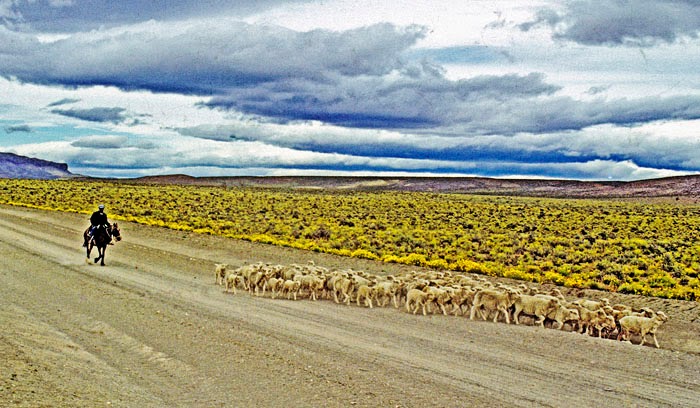Patagonian sheep enjoy great social life, much space to roam over, and
plenty to eat. But, as in some human societies, at some time in their lives
they must go under the knife. And sooner or later they end up as roast meat.
This post includes
12 photographs
A gaucho herds sheep back to an estancia’s white buildings, visible as white dots above
the horse’s head along the San José Gulf, at the tip of the Valdés Peninsula. They
are needed there to be sheared.
Under a heavy sky, along fields of wild yellow flowers, a gaucho is herding sheep back to a corral in Patagonia’s Chubut Province.
Gauchos marking lambs's ears. To rapidly distinguish between capons, ordinary
females, and females reserved for breeding, the men cut capons’tails midway
and those of ordinary females entirely. They let the breeders keep their tails.
In Patagonia’s
Valdés Peninsula sheep await their turn to be shorn of
their wool.
In Patagonia’s Valdés Peninsula gauchos are chasing sheep towards
the shearing shed.
Inside the shed of a Valdés Peninsula’s estancia, a dozen men are
shearing sheep. Their shears come attached to the tentacles of a motorized
machine built like a carousel. Legs tied, other sheep lie around awaiting their
turn.
Shorn sheep returning to pasture.
Preparing wool to be packed.
Waiting
for more wool before closing the bundle.
Stacking bundles of wool for pick up.
Marking bundles for pick up.
A Puerto Madryn-based veterinarian, owner of the large Valdés Peninsula
hacienda shown in some of the above photographs, is sharing a barbecued rack of
sheep with his two gauchos and me. He helped me find the two horses I used in a
1984 Patagonia crossing whose story Smithsonian magazine published.
To view more Patagonia photos on this blog, write the word in the search
box.
All the photographs of this blog
are copyrighted.
No usage permitted without prior
authorization.






















